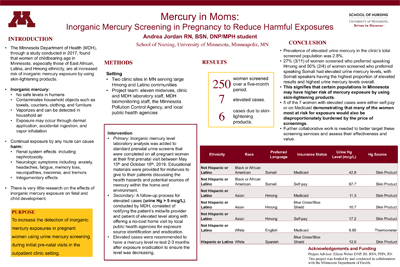Andrea Jordan
MPH, Public Health Practice
Advisor:
Dr. Eileen Weber
Educational Objectives:
- Compare organic and inorganic mercury and their environmental sources.
- Understand potential screening processes for inorganic mercury.
- Discuss the health threats of skin-lightening products and populations who may be at higher risk for their use.
Keywords:
Mercury, Skin-lightening
Abstract
Women of childbearing age in Minnesota, especially those of East African, Hmong, and Latina ethnicity, are at increased risk of inorganic mercury exposure through the use of skin-lightening products. Inorganic mercury exposure may harm the renal, neurologic, and integumentary systems, and it is unclear if inorganic mercury poses any risk to a developing fetus.
Despite the clear potential for harm, there are currently no guidelines for screening at-risk populations. The aim of this quality improvement project was to increase detection of inorganic mercury exposures in pregnant women.
A process was developed and implemented in two large federally qualified health center sites to educate and screen all pregnant women for inorganic mercury exposure by conducting urine testing at their initial prenatal visit. State and local public health agencies followed up with elevated cases, offering a no-charge home visit for mercury source detection and disposal.
Over five months, 250 patients were screened with seven elevated cases and seven home visits completed. Mercury sources identified included various skin care products and a broken mercury thermometer.
This quality improvement project highlights the value of expanding screening for inorganic mercury exposures to increase public and provider awareness of the potential harm from the use of skin-lightening products.

View Poster (PDF)
